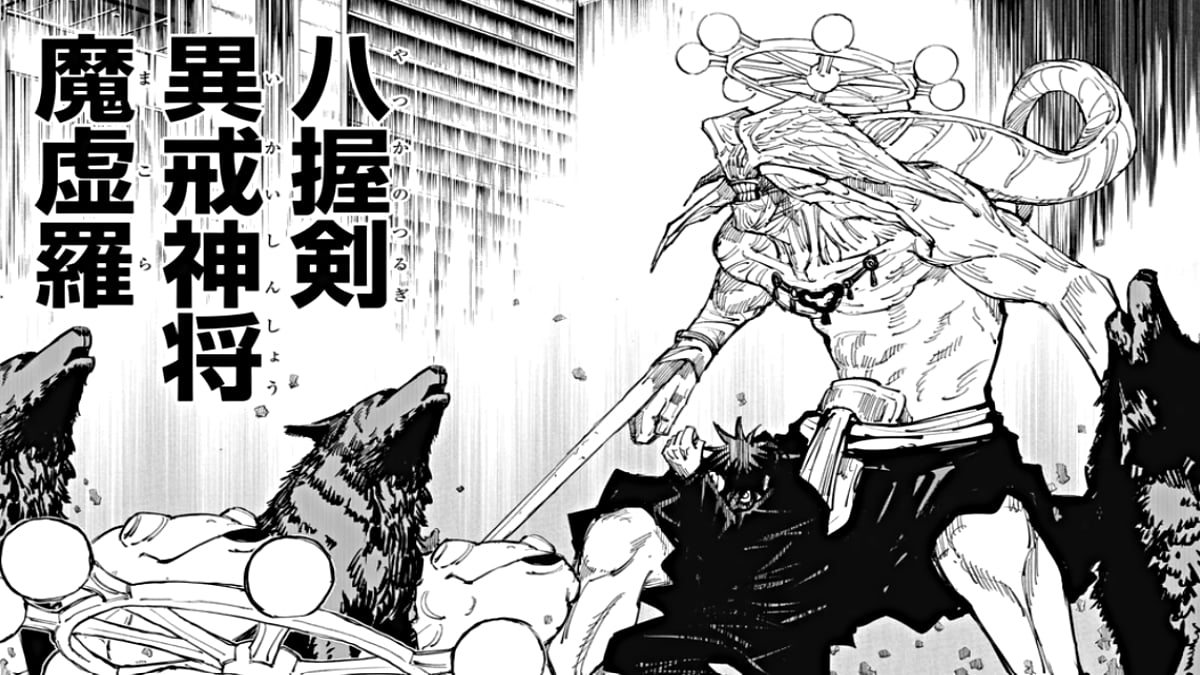Gege Akutami’s Jujutsu Kaisen is rapidly ascending to legendary status, thanks to its exceptional content and distinctive style. Its strength lies in a plot brimming with captivating supernatural themes, crafting a JJK world that is both intriguing and mysterious. While the catalog of terminologies in the series is vast, they’re all necessary prerequisites to enjoy the legendary manga and anime fully.
In its current second season, the Jujutsu Kaisen anime consistently astonishes viewers with perilous and exhilarating battles. The recent development involves the reincarnation of Toji Fushiguro, the epic fight between Gojo and Sukuna, and Toji’s son Megumi lying rescued by Sukuna, who is harboring his own plans for utilizing the young sorcerer’s powers, specifically the Mahogara.
Looking ahead in the anime, the storyline is poised for a dramatic shift as Sukuna contemplates summoning Mahoraga using Megumi’s Ten Shadows Technique. The looming question is: What exactly is Mahoraga, and what powers does it possess?
What is Mahoraga and who uses it?
Mahoraga, called the Eight-Handled Sword Divergent Sila Divine General Mahoraga in full, is the most powerful shikigami of the Ten Shadows Technique. This technique is possessed by the Zenin family, allowing them to collect and summon up to ten different shikigami or spirit creatures. These ten shinigami are two Demon Dogs, Nue, Toad, Great Serpent, Max Elephant, Rabbit Escape, Piercing Ox, Round Deer, and finally the Mahoraga. However, not a single person who has used the Ten Shadows Technique has ever succeeded in exorcising Mahoraga.
The Mahogara made its debut in the anime in season 2 episode 16 after first being hinted at in episode 5. In the manga, it finds its debut in chapter 117 after being partially named in chapter 9.
Like a number of other aspects of the series that have Buddhist and Hindu roots, Mahoraga is influenced by Buddhist mythology. Mahoraga is described in Buddhist writings as a divine being belonging to one of the eight classes of deities that guard the Dharma. The Eight Legions are the aggregate name for these classes. Their function is to assist and guard the Buddha, and they are frequently portrayed as serpentine deities.
What are Mahogara’s powers?
The Zenin family members consider Mahoraga their ultimate weapon, which is essentially an ancient being deriving power from its Eight-Handled Wheel and the Sword of Extermination. An essential component of Mahoraga’s design is the wheel, which symbolizes the shikigami’s ability to transform and adapt in order to fend off attacks from its adversaries. As demonstrated in the battle with Sukuna, it is capable of countering even the most formidable techniques of the opponent.
The Sword of Extermination, which initially appears to be a straightforward blade fastened to Mahoraga’s right arm, is the second power source of the Mahogara. But the Sword of Extermination’s actual power comes from its evil, cursed energy rather than its good energy.
Mahoraga’s power was seen when Megumi finally summoned it after being severely injured by Haruta Shigemo in Shibuya. Even after Sukuna arrived and used his Dismantle technique to damage the shikigami, Mahoraga was able to send Sukuna crashing through numerous buildings once the wheel on its head turned the first time. It was also able to see and deflect Dismantle the next time Sukuna attempted to use it. If Mahoraga bows to Sukuna’s will, nothing in the sorcerer’s world is too impossible.
Jujutsu Kaisen intricately weaves complex plot elements and concepts. To grasp the essence of Mahogara, it’s crucial to familiarize yourself with key terminologies featured in the series. Mahogara, for instance, is invoked through the Ten Shadows Technique—a cursed technique inherited within the Zenin family. This technique empowers the user to summon 10 distinct shikigami. What are these you ask?
What do inherited cursed techniques mean in Jujutsu Kaisen?
Jujutsu Kaisen intricately weaves a narrative around diverse sorcerer clans passing down generations-old cursed techniques, which are thus called “inherited.” These techniques serve as pivotal factors in delineating and determining the prowess of individual sorcerers.
The narrative spotlights three eminent sorcerer families—the Zenin Family, the Gojo Family, and the Kamo Family—each wielding considerable influence and political prominence within the jujutsu realm. With a lineage extending over a millennium, the members of these families have transmitted potent inherited techniques across generations, thereby shaping the dynamic landscape of the jujutsu world
What is a Shikigami in Jujutsu Kaisen?
Simply put, Shikigamis in Jujutsu Kaisen are monstrous entities resembling cursed spirits, summoned as familiars by Jujutsu users known as Shikigami Users. These creatures, unseen by non-sorcerers, are harnessed and controlled by their masters through mediums like talismans and various sorcery techniques.
Shikigami conjuration is categorized as a form of cursed technique, with these familiars representing the incarnation of their summoner’s cursed energy. Notably, only a select few individuals in Jujutsu Kaisen are Shikigami Users, with prominent examples including Ryomen Sukuna and Megumi Fushiguro. Megumi employs the Ten Shadows Technique of the Zenin Family to summon shikigami, although the mechanics of the shikigami summoned through this technique differ from those of a conventional sorcerer’s simple shikigami.
Upon inheriting the Ten Shadows Technique, the recipient gains two Divine Dogs. However, summoning the remaining eight shikigami involves an exorcism ritual, requiring the user to defeat each shikigami to assert dominance. Once subjugated, these shikigami become entirely obedient to their master, accessible through the utilization of shadowgraphic hand signs that generate a shadow puppet representation of the specific familiar.
